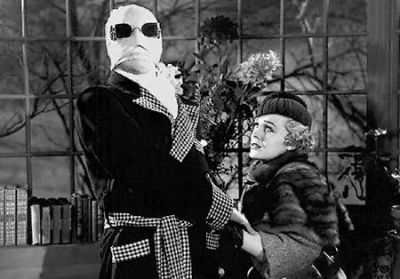
THE INVISIBLE MAN
(L'uomo invisibile, USA/1933) R.: James Whale. D.: 71'
Introducono Peter Schade (Universal) e Tom Burton (Technicolor)
T. it.: L'uomo invisibile. Sog.: dal romanzo omonimo di H.G. Wells. Scen.: R.C. Sherriff. F.: Arthur Edeson. M.: Ted Kent. Scgf.: Charles D. Hall. Mus.: W. Franke Harling. Int.: Claude Rains (Dr. Jack Griffin, l'uomo invisibile), Gloria Stuart (Flora Cranley), William Harrigan (Dr . Kemp), Henry Travers (Dr . Cranley), Una O'Connor (Jenny Hall), Forrester Harvey (Herbert Hall), Holmes Herbert (capo della polizia), E .E . Clive (agente Jaffers). Prod.: Carl Laemmle, Jr. per Universal Productions. Pri. pro.: 13 novembre 1933 DCP. D.: 71' . Bn. Versione inglese con sottotitoli italiani / English version with Italian subtitles
Da: Universal Pictures
Restaurato da Technicolor, in occasione del centenario della Universal Pictures / Restored by Technicolor for Universal Pictures' 100th Anniversary
Togliete a un film di effetti speciali i trucchi visivi e gli ruberete l’anima. The Invisible Man (1933), magnifico film della Universal tratto dal celebre romanzo di H.G. Wells, è una solida eccezione a questa regola. I film fantastici che come questo reggono alle devastazioni del tempo si contano sulla punta delle dita, e The Invisible Man è un monumento al genio di quattro artisti di vaglia: il regista James Whale, lo sceneggiatore R.C. Sherriff, il mago degli effetti speciali John P. Fulton e l’attore Claude Rains. La combinazione di questi talenti è così geniale che è difficile immaginare il film senza uno solo di loro. […] Il film uscì quando la fama di H.G. Wells era quasi al culmine. I recensori, sempre rispettosi nei confronti dell’eminente scrittore, accolsero le buone intenzioni di Whale con una pioggia di critiche entusiastiche. (In realtà solo il primo terzo del film è fedele a Wells.) The Invisible Man divenne subito uno dei più acclamati film fantastici dell’epoca, e più di mezzo secolo dopo la sua fama rimane intatta. […] Ancora una volta il regista evita caparbiamente la maggior parte delle convenzioni del cinema dell’orrore. I migliori momenti del film uniscono umorismo nero e stupore (per esempio nella splendida scena dello smascheramento). L’agente Jaffers (E.E. Clive), comicamente pomposo, si affanna a mantenere un contegno mentre Griffin si toglie i vestiti. Segue la folle e sgangherata corsa di Jaffers e degli abitanti del villaggio che incespicando e ruzzolando cercano di ammanettare la camicia in fuga. L’inventiva di John Fulton era destinata a diventare la norma, ma conserva qui tutta la sua freschezza perché Whale non permette mai a The Invisible Man di diventare soltanto un film di effetti speciali. Il ritmo splendidamente costruito rende la prima parte del film un tour de force drammatico oltre che tecnico. In un altro memorabile faccia a faccia con la legge, Griffin toglie i pantaloni a un poliziotto. Qualche momento dopo, in una strada di campagna, assistiamo alla corsa a perdi fiato di una donna inseguita dallo stesso paio di pantaloni, che saltellano accompagnati da un motivetto allegro. È ancora oggi una scena straordinaria, e bisogna pensare all’impatto che episodi del genere potevano avere sugli spettatori del 1933 che li vedevano per la prima volta.
Michael Brunas, John Brunas, Tom Wea- ver, Universal Horrors. The Studio’s Clas- sic Films, 1931-1946, McFarland, Jefferson, NC-London 1990
Deprive the average special effects film of its visual tricks and you rob it of its heart and soul. The Invisible Man, Universal’s superb 1933 filmization of one of H.G. Wells’ most enduring novels, is a firm exception to this rule. One of the handful of fantastic films unblemished by the ravages of time, The Invisible Man is a monument to the genius of four remarkable artists: director James Whale, screenwriter R.C. Sherriff, special effects ace John P. Fulton and star Claude Rains. So brilliant is this diverse combination of talents, it’s difficult to image what the film would have been like minus the participation of any one of them. […] The film was released at a time when the literary reputation of H.G. Wells was near its peak. Film reviewers, ever respectful of the distinguished man of latters, applauded Whale’s good intentions with a shower of enthusiastic notices. (Actually, only the first third of the picture is truly faithful to Wells.) The Invisible Man instantly became one of the most acclaimed fantasy films of its day, and its reputation more than half a century later remains intact. […] Again, the director stubbornly avoids most of the formulaic, heavy-handed horror movie conventions. The best moments combine black comedy with a sense of awe (for example, the superb unmasking scene). The laughably pompous Constable Jaffers (E.E. Clive) struggles to keep his authoritative pose as Griffin whisks off his clothes. A madcap chase ensues as Jaffers and the villagers, literally tumbling over one another, try to handcuff the prancing shirt. John Fulton’s inventive technique was soon to become commonplace in pictures, but the effects here remain fresh and witty because Whale never allows The Invisible Man to become just a special effects picture. The director’s splendid build-up in the expertly paced opening reels makes the film a dramatic as well as a technical tour de force. In another memorable confrontation with the law, Griffin pulls the trousers off a bobby. Moments later, we see a terrified woman charging down a country lane, pursued by the same pair of trousers merrily skipping along to a jaunty ditty. It’s still a great scene, and one has to appreciate the shock value these episodes must have had on a 1933 audience experiencing them for the first time.
Michael Brunas, John Brunas, Tom Weaver, Universal Horrors. The Studio’s Classic Films, 1931-1946, McFarland, Jefferson, NC-London 1990

Tariffe:
Aria condizionata
Accesso disabili
Tel. 051 522285











